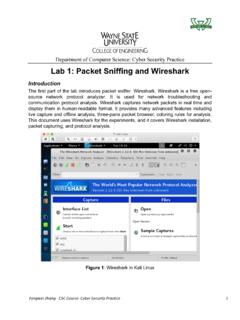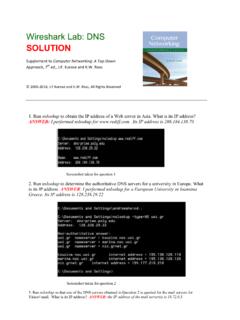Transcription of Lab 1: Packet Sniffing and Wireshark - Wayne State University
1 Fengwei Zhang - CSC 5991 Cyber Security Practice 1 CSC 5991 Cyber Security Practice Lab 1: Packet Sniffing and Wireshark Introduction The first part of the lab introduces Packet sniffer, Wireshark . Wireshark is a free open-source network protocol analyzer. It is used for network troubleshooting and communication protocol analysis. Wireshark captures network packets in real time and display them in human-readable format. It provides many advanced features including live capture and offline analysis, three-pane Packet browser, coloring rules for analysis. This document uses Wireshark for the experiments, and it covers Wireshark installation, Packet capturing, and protocol analysis.
2 Figure 1: Wireshark in Kali Linux Fengwei Zhang - CSC 5991 Cyber Security Practice 2 Background TCP/IP Network Stack Figure 2: Encapsulation of Data in the TCP/IP Network Stack In the CSC 4190 Introduction to Computer Networking (one of the perquisite courses), TCP/IP network stack is introduced and studied. This background section briefly explains the concept of TCP/IP network stack to help you better understand the experiments. TCP/IP is the most commonly used network model for Internet services. Because its most important protocols, the Transmission Control Protocol (TCP) and the Internet Protocol (IP) were the first networking protocols defined in this standard, it is named as TCP/IP.
3 However, it contains multiple layers including application layer, transport layer, network layer, and data link layer. - Application Layer: The application layer includes the protocols used by most applications for providing user services. Examples of application layer protocols are Hypertext Transfer Protocol (HTTP), Secure Shell (SSH), File Transfer Protocol (FTP), and Simple Mail Transfer Protocol (SMTP). Fengwei Zhang - CSC 5991 Cyber Security Practice 3 - Transport Layer: The transport layer establishes process-to-process connectivity, and it provides end-to-end services that are independent of underlying user data.
4 To implement the process-to-process communication, the protocol introduces a concept of port. The examples of transport layer protocols are Transport Control Protocol (TCP) and User Datagram Protocol (UDP). The TCP provides flow-control, connection establishment, and reliable transmission of data, while the UDP is a connectionless transmission model. - Internet Layer: The Internet layer is responsible for sending packets to across networks. It has two functions: 1) Host identification by using IP addressing system (IPv4 and IPv6); and 2) packets routing from source to destination.
5 The examples of Internet layer protocols are Internet Protocol (IP), Internet Control Message Protocol (ICMP), and Address Resolution Protocol (ARP). - Link Layer: The link layer defines the networking methods within the scope of the local network link. It is used to move the packets between two hosts on the same link. An common example of link layer protocols is Ethernet. Packet Sniffer Packet sniffer is a basic tool for observing network Packet exchanges in a computer. As the name suggests, a Packet sniffer captures ( sniffs ) packets being sent/received from/by your computer; it will also typically store and/or display the contents of the various protocol fields in these captured packets.
6 A Packet sniffer itself is passive. It observes messages being sent and received by applications and protocols running on your computer, but never sends packets itself. Figure 3 shows the structure of a Packet sniffer. At the right of Figure 3 are the protocols (in this case, Internet protocols) and applications (such as a web browser or ftp client) that normally run on your computer. The Packet sniffer, shown within the dashed rectangle in Figure 3 is an addition to the usual software in your computer, and consists of two parts. The Packet capture library receives a copy of every link-layer frame that is sent from or received by your computer.
7 Messages exchanged by higher layer protocols such as HTTP, FTP, TCP, UDP, DNS, or IP all are eventually encapsulated in link-layer frames that are transmitted over physical media such as an Ethernet cable. In Figure 1, the assumed physical media is an Ethernet, and so all upper-layer protocols are eventually encapsulated within an Ethernet frame. Capturing all link-layer frames thus gives you access to all messages sent/received from/by all protocols and applications executing in your computer. The second component of a Packet sniffer is the Packet analyzer, which displays the contents of all fields within a protocol message.
8 In order to do so, the Packet analyzer Fengwei Zhang - CSC 5991 Cyber Security Practice 4 Figure 3: Packet Sniffer Structure must understand the structure of all messages exchanged by protocols. For example, suppose we are interested in displaying the various fields in messages exchanged by the HTTP protocol in Figure 3. The Packet analyzer understands the format of Ethernet frames, and so can identify the IP datagram within an Ethernet frame. It also understands the IP datagram format, so that it can extract the TCP segment within the IP datagram. Finally, it understands the TCP segment structure, so it can extract the HTTP message contained in the TCP segment.
9 Finally, it understands the HTTP protocol and so, for example, knows that the first bytes of an HTTP message will contain the string GET, POST, or HEAD . We will be using the Wireshark Packet sniffer [ ] for these labs, allowing us to display the contents of messages being sent/received from/by protocols at different levels of the protocol stack. (Technically speaking, Wireshark is a Packet analyzer that uses a Packet capture library in your computer). Wireshark is a free network protocol analyzer that runs on Windows, Linux/Unix, and Mac computers. Fengwei Zhang - CSC 5991 Cyber Security Practice 5 Getting Wireshark The Kai Linux has Wireshark installed.
10 You can just launch the Kali Linux VM and open Wireshark there. Wireshark can also be downloaded from here: Figure 4: Download Page of Wireshark Fengwei Zhang - CSC 5991 Cyber Security Practice 6 Starting Wireshark When you run the Wireshark program, the Wireshark graphic user interface will be shown as Figure 5. Currently, the program is not capturing the packets. Figure 5: Initial Graphic User Interface of Wireshark Then, you need to choose an interface. If you are running the Wireshark on your laptop, you need to select WiFi interface. If you are at a desktop, you need to select the Ethernet interface being used.




